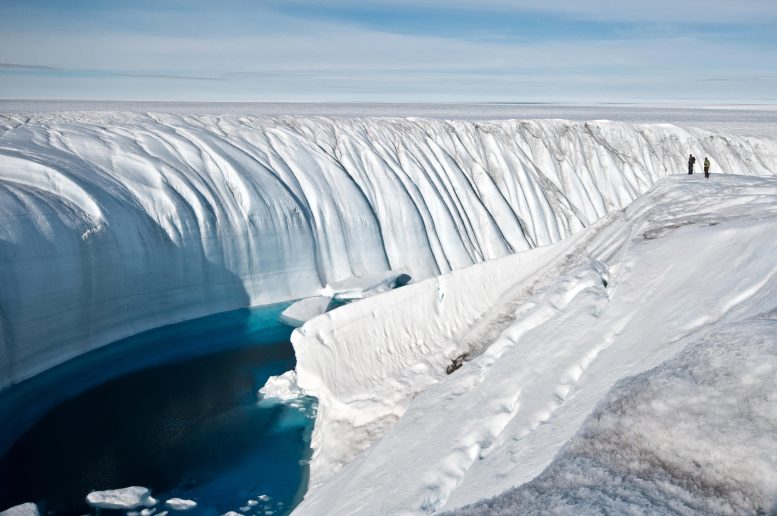Global warming has caused extreme ice melting events in Greenland to become more frequent and more intense over the past 40 years according to new research, raising sea levels and flood risk worldwide.
Over the past decade alone, 3.5 trillion tonnes of ice has melted from the surface of the island and flowed downhill into the ocean.
That’s enough melted ice to cover the entire UK with around 15 meters (50 feet) of meltwater, or cover the entire city of New York with around 4500 meters (15,000 feet).
The new study, led by the University of Leeds, is the first to use satellite data to detect this phenomena – known as ice sheet runoff – from space.
The findings, published in Nature Communications, reveal that Greenland’s meltwater runoff has risen by 21% over the past four decades and has become 60% more erratic from one summer to the next.
Lead author Dr. Thomas Slater, a Research Fellow in the Centre for Polar Observation and Modelling at the University of Leeds said:
“As we’ve seen with other parts of the world, Greenland is also vulnerable to an increase in extreme weather events.
“As our climate warms, it’s reasonable to expect that the instances of extreme melting in Greenland will happen more often – observations such as these are an important step in helping us to improve climate models and better predict what will happen this century.”
The study, funded by the European Space Agency (ESA) as part of its Polar+ Surface Mass Balance Feasibility project, used measurements from the ESA’s CryoSat-2 satellite mission.
The research shows that over the past decade (2011 to 2020), increased meltwater runoff from Greenland raised the global sea level by one centimeter. One third of this total was produced in just two hot summers (2012 and 2019), when extreme weather led to record-breaking levels of ice melting not seen in the past 40 years.
Raised sea levels caused by ice melt heightens the risk of flooding for coastal communities worldwide and disrupts marine ecosystems in the Arctic Ocean that indigenous communities rely on for food.
It can also alter patterns of ocean and atmospheric circulation which affect weather conditions around the planet.
During the past decade, runoff from Greenland has averaged 357 billion tonnes per year, reaching a maximum of 527 billion tonnes of ice melt in 2012, when changes in atmospheric patterns caused unusually warm air to sit over much of the ice sheet. This was more than twice the minimum runoff of 247 billion tonnes that occurred in 2017.
The changes are related to extreme weather events, such as heatwaves, which have become more frequent and are now a major cause of ice loss from Greenland because of the runoff they produce.
Dr. Slater said: “There are, however, reasons to be optimistic. We know that setting and meeting meaningful targets to cut emissions could reduce ice losses from Greenland by a factor of three, and there is still time to achieve this.”
These first observations of Greenland runoff from space can also be used to verify how climate models simulate ice sheet melting which, in turn, will allow improved predictions of how much Greenland will raise the global sea level in the future as extreme weather events become more common.
Study co-author Dr. Amber Leeson, Senior Lecturer in Environmental Data Science at Lancaster University, said:
“Model estimates suggest that the Greenland ice sheet will contribute between about 3 and 23 cm (1 and 9 in) to global sea level rise by 2100.
“This prediction has a wide range, in part because of uncertainties associated with simulating complex ice melt processes, including those associated with extreme weather. These new spaceborne estimates of runoff will help us to understand these complex ice melt processes better, improve our ability to model them, and thus enable us to refine our estimates of future sea level rise.”
Finally, the study shows that satellites are able to provide instant estimates of summer ice melting, which supports efforts to expand Greenland’s hydropower capacity and Europe’s ambition to launch the CRISTAL mission to succeed CryoSat-2.
ESA’s CryoSat mission manager, Tommaso Parrinello, said:
“Since it was launched over 11 years ago, CryoSat has yielded a wealth of information about our rapidly changing polar regions. This remarkable satellite remains key to scientific research and the indisputable facts, such as these findings on meltwater runoff, that are so critical to decision-making on the health of our planet.
“Looking further to the future, the Copernicus Sentinel Expansion mission CRISTAL will ensure that Earth’s vulnerable ice will be monitored in the coming decades. In the meantime, it is imperative that CryoSat remains in orbit for as long as possible to reduce the gap before these new Copernicus missions are operational.”
Reference: “Increased variability in Greenland Ice Sheet runoff from satellite observations” by Thomas Slater, Andrew Shepherd, Malcolm McMillan, Amber Leeson, Lin Gilbert, Alan Muir, Peter Kuipers Munneke, Brice Noël, Xavier Fettweis, Michiel van den Broeke and Kate Briggs, 1 November 2021, Nature Communications.
DOI: 10.1038/s41467-021-26229-4










“Raised sea levels caused by ice melt heightens the risk of flooding for coastal communities worldwide …”
This claim doesn’t hold up to scrutiny. We are supposed to believe that an increase of less than 1/2 an inch (1 cm) in a decade is going to have a significant influence on the risk of flooding? Reasonable people set their homes back from the water’s edge to allow for tides and storm surges. Assuming that they miscalculate, and don’t leave enough margin for error, and they get flooded, is another 1/2″ really going to make a difference? This just sounds like a scare tactic based on the assumption that most readers can’t see through the subterfuge. That goes along with the claim that the Greenland meltwater from the last decade would cover the city of New York with 4500 meters of water. What a stupid, irrelevant metric! Its just an opportunity to flash some big numbers that are meaningless.
If I didn’t know better, I might assume that there was some kind of important international climate meeting going on at the moment, which needs reinforcement to push the lemmings over the cliff.
Yet another denialist pushing fake news like the flat earthers, young-earth creationists and anti-vaxxers.
It would be hilarious watching reality denial like this in operation if people’s lives were not at risk from this sort of utter nonsense.
Yet another climate change alarmist that refuses to debate facts. Can’t do it, so he wants to assume irrelevant BS and change subject to flat Earth nonsense.
It is interesting that instead of attempting to show that my facts or logic are wrong, you whip out your most damaging response — insults! What does that say about you?
Just for the record, I don’t believe that the Earth is flat, nor do I believe in creationism, and I regularly get vaccinations when appropriate. Since you are so completely wrong about your characterization of me, what can we conclude about the other things that you believe without benefit of facts? You called me a “denialist,” yet it would seem that you are the person who is actually in denial of facts and the nature of reality. At least you don’t seem to be able to articulate any facts to support your belief system. It seems to happen frequently that those who disagree with me in this forum can’t rise about insults unsupported by evidence. It is a sad state of affairs when people resort to insults instead of facts, and then accuse others of doing the same thing. It is called “projection.”
So how much money does individual Americans have to pay in taxes and carbon charges to save the rest of the world from global warming while commercial jet manufactures continue to build new global warming jets to keep the commercial jet industry alive not including all the corporate private jets still being produced? I guess if we have enough money we can cover China and Russia’s global warming too.
Clyde is an uneducated lemming shill. Go back to faux fake news trumper.
Just how is it that you know my level of education? You don’t! Therefore, it is obvious that you are making up insults because you don’t have any actual facts or logic to counter what I have written. There is an old saying that when you point a finger at someone, there are 4 fingers pointing back at yourself. You would seem to be an example of what you accuse me of.
You haven’t demonstrated anything that would allow anyone to guess your maximum level of education. However, you have left us with clues about the minimum.